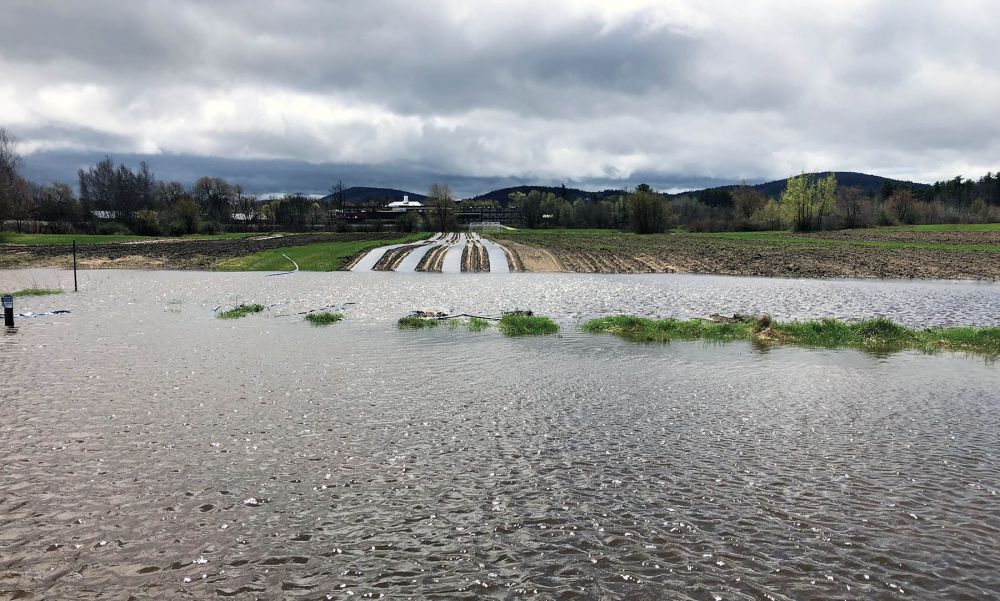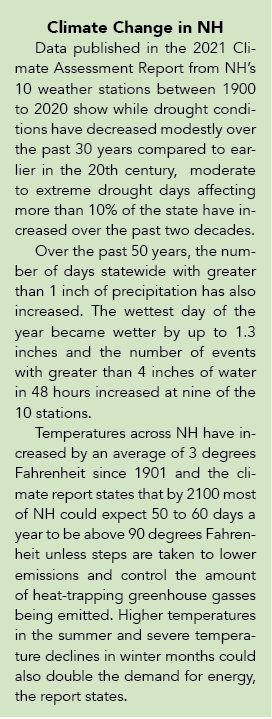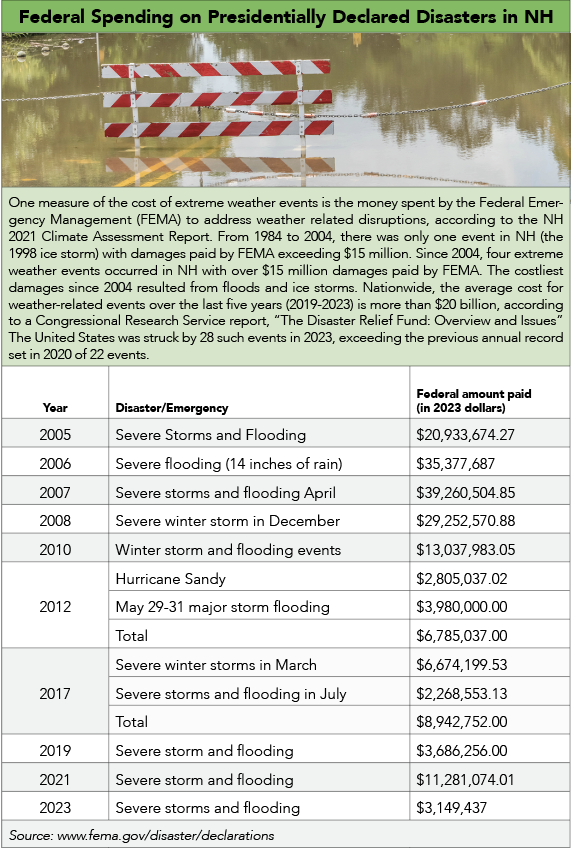 Flooded fields on a farm in Carroll County from a May 2023 flooding event. (Courtesy of UNH)
Flooded fields on a farm in Carroll County from a May 2023 flooding event. (Courtesy of UNH)
Extreme weather has been grist for Hollywood disaster movies with torrential rains washing away cities and cold snaps quickly turning into a new ice age. While they make for great big-screen spectacles, they are rarely rooted in science. However, actual climate change is having devastating effects on communities across the country, and it is acutely felt by farmers.
The freeze in February 2023 that killed off peach crops throughout New England is just one example of how climate change is hurting NH farms. That was followed by another frost in May and then dry spells punctuated by heavy rains. Such extreme weather is becoming more common and affecting crops from apples to blueberries.
This volatile new reality creates additional uncertainties for the agriculture industry, which, while used to cyclical weather and conditions, struggles with more frequent extreme weather.
New Hampshire’s agricultural industry encompasses a variety of crops, livestock, and specialty products. The value of the state’s agricultural industry is approximately $1.2 billion, which includes direct sales of agricultural and horticultural products and revenue related to agritourism, according to the NH Department of Agriculture, Markets & Food. While NH’s agricultural industry represents under 2% of the state’s GDP, it includes high-value crops like apples, dairy products, and maple syrup, which contribute to the state’s agritourism, economic diversity, and helps to support rural communities.
Seasonal Cycles Replaced by Unpredictable Weather
Olivia Saunders began working with the UNH Cooperative Extension 11 years ago and says today much of her work focuses on helping farms mitigate crop damage from extreme weather and other factors, such as insects.
“In 2023 the temperatures were pretty devastating,” she says, referring to the hard freeze that killed much of New England’s peach crop. “That crop is marginal in New Hampshire but in the southern reaches there are quite a few farms growing a lot of peaches.”
 On Feb. 3, 2023, arctic air brought record-breaking cold temperatures to NH. Mount Washington recorded a temperature of negative 47 degrees Fahrenheit and a wind chill of negative 108 degrees Fahrenheit, the lowest ever documented in the U.S. since current wind chill scales were implemented. Other parts of the state were well below zero with the coldest readings in decades, according to the National Weather Service. The average temperature in Concord on Feb. 4 was negative 8 degrees Fahrenheit.
On Feb. 3, 2023, arctic air brought record-breaking cold temperatures to NH. Mount Washington recorded a temperature of negative 47 degrees Fahrenheit and a wind chill of negative 108 degrees Fahrenheit, the lowest ever documented in the U.S. since current wind chill scales were implemented. Other parts of the state were well below zero with the coldest readings in decades, according to the National Weather Service. The average temperature in Concord on Feb. 4 was negative 8 degrees Fahrenheit.
Temperatures across the state eventually rose but then fell significantly again in the spring. On May 17 and 18 of last year, nearly 75% of the state’s apple crop was lost to a hard frost. “We haven’t really had anything happen like this on such a scale,” Saunders says. “It also really affected blueberries and even some strawberries.”
One of the problems today, says Roger Sorkin, whose latest film “Farm Free or Die” documents the financial difficulties posed by climate change for farmers (see sidebar), is a lack of predictable weather. Sorkin is an award-winning producer, writer, editor, director and founder of the American Resilience Project, a nonprofit dedicated to strengthening civic engagement to address challenges in the United States. “For decades and centuries we knew that frosts would occur at certain times of the year and that pest infestations would occur at certain times of the year or in multi-year cycles,” he says. “There was a bit more of an ability to plan. Now there’s much less ability to plan and it’s that volatility in the system that is really affecting farmers.”
Saunders says it’s hard to link a specific one-day event to climate change but explains that big fluctuations in temperatures are a problem for many crops that begin to bloom when temperatures rise and then cannot survive when they plummet.
Saunders says there has been an accumulation of higher degree days in NH earlier in the winter and spring seasons. “When the frost risk isn’t gone, that’s when you can have these termination events,” she says, explaining that as temperatures rise the risk of frost events will eventually diminish. “In the long term, 30 to 50 years down the road, that risk is diminished. But for the next couple of decades we’re at a higher risk to frost damage than we used to be.”
Matt LeClair, owner of Barrett Hill Farm in Mason that employs between 10 and 15 full-time employees, lost his entire peach crop in 2023. He refers to the storm that took his peach crop as the “perfect storm.”
“It was severely cold but not brutally cold last winter. Then that one weekend it went down to minus 18 or minus 20 [degrees Fahrenheit] below zero. Peaches don’t like to go more than -5 degrees Fahrenheit,” he says, explaining that when the buds aren’t hardened, and a hard freeze takes place, it can be devastating. “If we’d had a winter of 10 below they might have been able to handle it.”
LeClair, who has been farming for 40 years and whose father and grandfather were also farmers, says erratic weather has always been an issue. “Five or six years ago we lost all our peaches too. If you look through history, peaches are tricky, especially the farther north you go.”
Another big challenge, LeClair says, is extremely wet seasons as excessive rain makes it hard to grow and harvest the hay used to feed his cattle. LeClair says the idea of there being an “average year” for farmers is “almost like a unicorn … it’s a magical thing.”
Climate Resilient Crops and Other Strategies
The climate can be like a yo-yo, and farmers must adapt. While drought warnings were in effect for much of summer 2022, last year was very wet. What’s consistent is it keeps getting hotter.
“Some of our crops don’t really like the heat as much, especially excessive heat like 90 degrees,” Saunders says. “That type of heat can really influence pollination, fruit development and even germination of a seed in the soil.”
Many Brassica crops, which include broccoli, cabbages, kale, turnips and others, prefer a cooler growing environment. The same goes for spinach and lettuce. With temperatures warming, Saunders says NH farmers are looking at growing crops typically grown in southern states. “Sweet potatoes are a newer crop in the northeast typically grown in the southern U.S. that do really good in the heat,” she says, explaining that crops like squash that sit on the surface are more susceptible to heat and fungal diseases. “Putting in some sweet potato might be a climate resilient crop.”
Longer periods of warmer temperatures mean more insects, creating another challenge for crops. “We are seeing more insect pressure because of the warmer temperatures,” she says.
“One alternative to spraying pesticides on crops to control the insects, and brand new to New Hampshire, is covering them. This also protects the crop from hail,” says Saunders, referring to a growing practice of using netting that hangs over a metal frame to protect blueberries from invasive insects.
Another practice small farms are using is “high tunnels” or plastic covered hoop houses that look like greenhouses. Like greenhouses, these plastic coverings provide protection from the elements. Unlike greenhouses, these structures are temporary and crops are grown in the ground. Some provide additional heating that can help extend the life of a crop past its normal growing season.
 “If you’re growing tomatoes, for example,” she says, “you can get about four times the yield and they allow for winter growing,” Saunders says of using high tunnels, adding that produce like lettuce found at winter farmers markets is likely grown in these structures.
“If you’re growing tomatoes, for example,” she says, “you can get about four times the yield and they allow for winter growing,” Saunders says of using high tunnels, adding that produce like lettuce found at winter farmers markets is likely grown in these structures.
Heavy rain events are another issue as they can lead to soil runoff that carries fertilizer, pesticides and dirt into waterways. And with longer drier spells between rain storms, it is vital that soil be able to retain water. “We’re in a feast and famine situation,” Saunders says. She compares soil to a sponge and some sponges, she says, are more absorbent than others. The goal is to have soil that absorbs water, and this depends on its contents.
Some soil contains higher levels of clay or sand, Saunders explains, which is not good for absorbing water. “Soil health can be changed by how it is cultivated. One way of doing this is through a practice called no-till farming, an agricultural practice that eliminates mechanical tilling of the soil [that] is being adopted on farms that have a large acreage such as pumpkin farms,” Saunders says.
The use of organic additives like compost or other plant-based mulches can also add organic matter that improves soil health, Saunders says, adding that planting cover crops also protect soil. Cover crops include grasses and legumes, like peas and alfalfa.
High Temps Threaten Livestock and Humans
Vernon Family Farm, owned by Jeremiah and Nicole Vernon, began in 2014. The farm, open year-round, is located on 33 acres in Newfields along the Piscassic River and Route 87. The Vernons have a small number of crops but primarily run a livestock operation that processes cattle, sheep, pigs, and thousands of chickens.
“We definitely think climate change is real and it is definitely affecting our farm,” says Jeremiah Vernon. In 2019 the farm lost 600 of its chickens in a heat-related event involving temperatures reaching up to 114 degrees Fahrenheit. The cost of the loss amounted to over $7,000. “Since then, we’ve remodeled our chicken houses so they have black out fabric over the windows, fans, and a spray system to keep them cool,” he says.
Extreme heat is also dangerous for farm workers. The risk of heat stress and heat stroke for farm workers increases as average temperatures increase, Saunders says.
“There aren’t a lot of options not to farm in a short season like New Hampshire’s and farmers, who are often underpaid and overworked, are already at the front lines of climate change. We are throwing them into this environment of high heat,” Saunders says, adding that identifying signs of heat stress and taking breaks is important. Part of her job is educating farmers about the effects of heat on workers and how to protect them. “New Hampshire is not historically a hot state, and we don’t have a lot of education or resources on heat stress.”
Vernon says drought conditions and the climate crisis in general affects people emotionally as well due to the lack of predictability. “We have climate anxiety,” he says, explaining that while heavy rains have prevented the farm from holding outdoor events, “It’s nice to not have to worry about trucking in water. Sometimes we’ve been one rain away from needing to pump it in.”
Looking to the Future
LeClair says he considers his farm diverse enough to handle some of the consequences of unpredictable weather, but economic challenges remain steady. “What we’ve seen in more recent years is high input costs. When fuel goes up and fertilizer prices rise, that snowballs throughout agriculture,” he says. “Every corn field around the country is going to be more expensive to grow with these cost increases and then with the pandemic and the unavailability of parts … Dairy prices have never recovered.”
Vernon says he is planning to start a livestock program that would help the farm buy cows to supplement those bred on the farm. Vernon, a 10th generation New Londoner, says his big hope for the future—aside from weathering the challenges of climate change—is that farming in NH attracts more community support and involvement. He says there are three livestock farms he know of in NH that are closing in the next year or two. “These are smart, hardworking people. They’re not selling to big grocery stores, but they are part of their local economy,” he says.
“Farming is in dire straits,” he adds. “We need help.”

 Current Issue - May 2024
Current Issue - May 2024